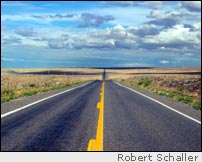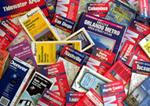Getting
Out There: |
Directory of all "Getting Out There" Articles> |
How to Make a "Speed Run" by Mark Sedenquist and Judy Carter
|
Whenever I can, I like to mosey on a road trip. What luxury is greater than having the time to let the spirit of the moment determine your route and destination? But the reality is that few of us have enough time to mosey to the grocery store, much less on a cross-country journey. Even when we take road-trip vacations, we're usually in a big hurry to get somewhere so we can begin to "relax" in earnest.
If you've ever covered 650 miles or more in a single day, you were on what we consider to be a "speed run." In most areas of the United States, a 650-mile trip requires about 11 hours of driving, and an 800-mile journey will take about 14 (including stops for fuel, food and traffic slowdowns). In my early road-tripping days, I pulled off a couple of "extreme speed runs," covering an average of 1,300 miles per day. Now I know this was not only silly but risky, considering how seriously fatigue affects coordination and the ability to multi-task effectively. Safe driving requires all faculties on high alert. Of course, car rally drivers and other kinds of racers drive extreme numbers of miles in a day, but they are operating on a closed track or controlled route. Don't consider them role models for road trips on regular roads, where there are no chase vehicles and unexpected hazards can pop up at every turn.
Covering lots of ground under time pressure is not a casual activity. As with every road trip, success starts in your brain, and both discipline and preparation are required. Whether your speed run is a solo effort or is undertaken with co-drivers, there are several fundamental techniques that can help ensure a successful and reasonably safe journey.
GET READY
|
Maps and routes
Even if your trip will include the services of a co-driver serving as navigator, it is smart to determine your route ahead of time, and it saves time, too. I carry a clipboard with a printed map of the day's general route. If I have booked reservations for lodging, I also include a detailed set of driving instructions for finding the motel at night.
Lodging or camping reservations
If you can't tolerate the risk of finding "no room at the inn," then make reservations. Personally, I prefer to keep that element of the trip unscripted. While reservations do guarantee a bed, they also limit my options, especially on a speed run when time is of the essence. Also, time spent at a motel or camping spot is going to be very short, so amenities beyond a clean bed and shower are not big priorities for me. On most routes, there are plenty of spur-of-the-moment lodging choices.
Mark Sedenquist and Judy Carter
September 17, 2006


